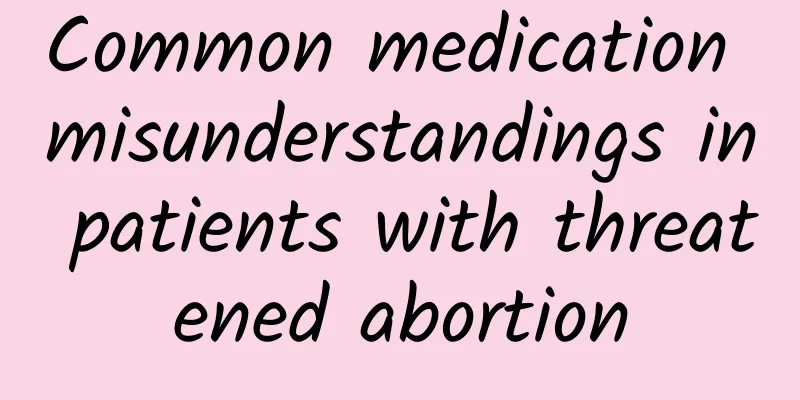Is vaginal bleeding a symptom of cervical erosion? What is the main cause of cervical erosion?

|
Vaginal bleeding is mostly caused by gynecological diseases, except during menstruation. Some gynecological diseases may not have other obvious manifestations, and it is usually not easy to judge what kind of disease it is from the symptoms. So, is vaginal bleeding a symptom of cervical erosion? To know whether vaginal bleeding is cervical erosion, we need to first understand cervical erosion. Cervical erosion used to be a disease that troubled many women. When going for a physical examination, it is almost nine out of ten times that you will be diagnosed with cervical erosion. Cervical erosion, after all, is actually a misunderstanding of the normal manifestation of the cervix in the past. Therefore, it is obvious that vaginal bleeding has nothing to do with cervical erosion. Main causes of vaginal bleeding: ⑴ Senile vaginitis, cervical erosion and cervical polyps, often with a small amount of fresh bleeding after gynecological examination or after sexual intercourse, may have bloody leucorrhea (sometimes leucorrhea is sorghum rice soup or amber), endometritis and endometrial hyperplasia can also cause vaginal bleeding. ⑵ Functional uterine bleeding and discontinuation of hormonal drugs such as progesterone, ethinyl estradiol, and birth control pills can cause vaginal bleeding. ⑶ Uterine fibroids, adenomyosis, cervical cancer, uterine body cancer and ovarian granulosa cell tumors can all cause vaginal bleeding accompanied by red and white discharge. ⑷ Thrombocytopenic purpura, leukemia and liver damage cause vaginal redness, accompanied by bleeding spots on the skin. ⑸ Irregular bleeding after menopause occurs in women of childbearing age. The first thing to consider is pregnancy-related diseases, such as miscarriage, ectopic pregnancy, hydatidiform mole, malignant hydatidiform mole, and choriocarcinoma. ⑹ Blood staining before or after menstruation, such as a small amount of bloody secretions a few days before or after menstruation, is generally due to abnormal ovarian function; irregular menstruation after IUD insertion. ⑺ Bleeding in late pregnancy may cause placenta previa, placental abruption, and uterine rupture. ⑻Pregnancy bleeding may be caused by placental retention, incomplete uterine involution, and puerperal infection. ⑼ Vaginal bleeding in young children may indicate vaginal sarcoma. ⑽ If menopausal women have irregular vaginal bleeding with heavy amount and long duration, endometrial cancer and reproductive malignancies should be ruled out. Vaginal bleeding is basically caused by disease, while cervical erosion is a normal physiological phenomenon. The two are unrelated, and it is important to correctly understand cervical erosion. There are many factors that lead to vaginal bleeding. If you cannot confirm it, it is best to go to the hospital for examination and never try to treat it yourself. |
Recommend
Do I need to diet before weight loss surgery? 5 Myths About Weight Loss Surgery Debunked
Morbid obesity is often treated with weight loss ...
What fruits should not be eaten during menstruation? Principles for choosing fruits
Being impatient and emotionally unstable are emot...
Preparations before medical abortion
Medical abortion is now favored by many female fr...
Symptoms of gynecological diseases If you have these 6 symptoms, you should pay attention
In our daily life, gynecological diseases have be...
What to do if you have miscarriage and uterine prolapse
What to do if you have miscarriage or uterine pro...
During the Mid-Autumn Festival, eat mooncakes and grapefruits, and be careful of the full moon! The "Round" Rescue Team teaches you tips on healthy eating
When I saw barbecue sauce advertisements starting...
Can miscarriage be cured?
Many women suffer from habitual miscarriages beca...
What foods should not be eaten when you have uterine fibroids? Four types of foods that women with uterine fibroids should not eat
1. Hot foods Due to the special physiological cha...
What are the clinical manifestations and hazards of bacterial vaginosis?
Bacterial vaginitis is the most common vaginal in...
Your menstrual cycle is different every time
Your menstrual cycle is different every time The ...
What are the specific preventive measures for cervical erosion?
I believe that female friends do not want to suff...
Can menopause be cured?
Can menopause be cured? Women approach or enter m...
How to treat second degree cervical erosion?
How to treat second degree cervical erosion? Cerv...
What are the clinical manifestations of female cervicitis? Will female cervicitis turn into cancer?
In fact, the body has already sent us some signal...
Paying attention to the precautions after abortion is the most important thing
In today's society, the most concerned thing ...









